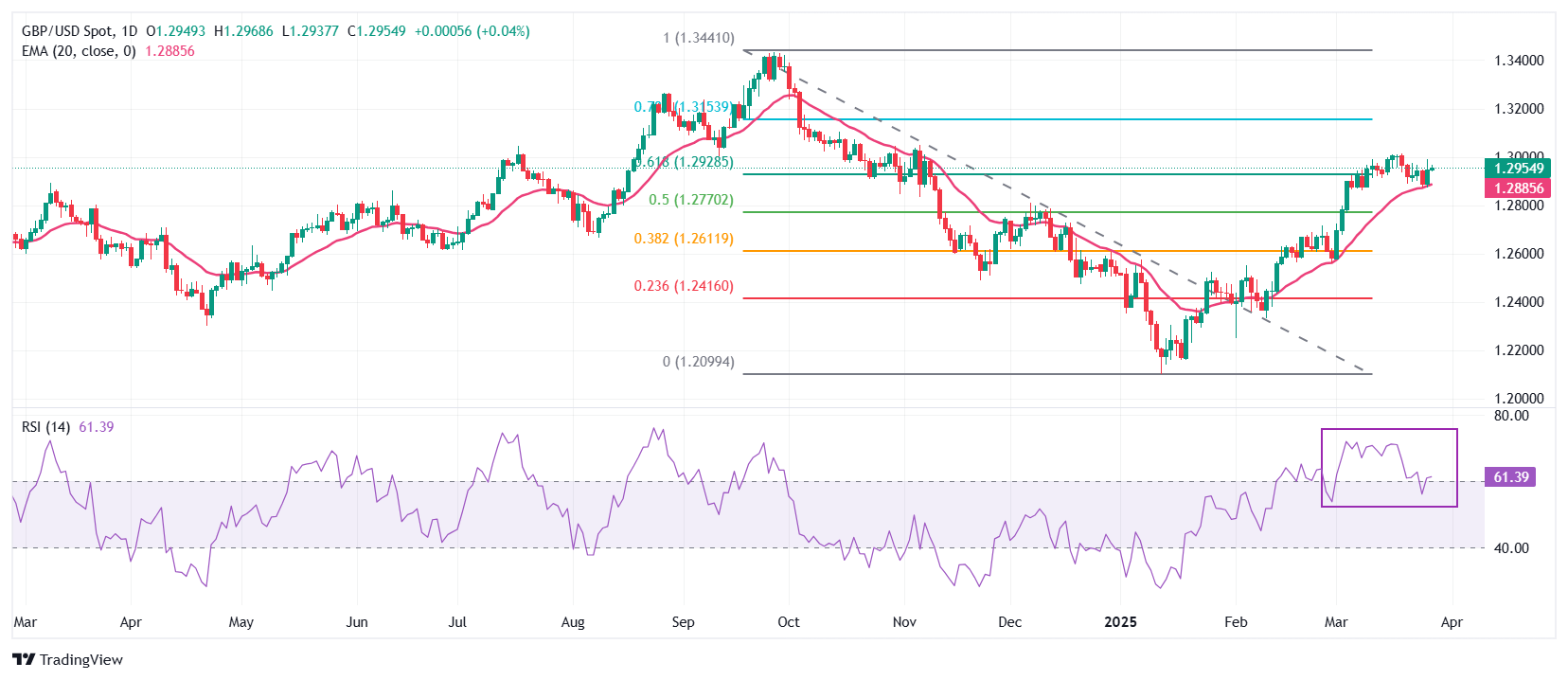Pound Sterling Gains As UK Retail Sales Surprisingly Grew In February
- The Pound Sterling rises against its peers on Friday after surprisingly upbeat UK Retail Sales data for February.
- The UK economy expanded at a robust pace of 1.5% in the last quarter of 2024.
- Investors brace for US PCE inflation and impending tariffs from US President Trump.
The Pound Sterling (GBP) advances against its major peers on Friday, except the Japanese Yen (JPY), after the release of the United Kingdom (UK) Retail Sales data for February and revised Q4 Gross Domestic Product (GDP) figures. The Office for National Statistics (ONS) reported that Retail Sales, a key measure of consumer spending, surprisingly rose by 1% month-on-month. Economists expected the data to have declined by 0.3%. In January, retail sales grew at a robust pace of 1.4%, revised lower from 1.7%.
In the 12 months to February, the consumer spending measure grew strongly by 2.2% compared to estimates of 0.5% and the former release of 0.6%, revised lower from 1%. Upbeat Retail Sales data is expected to support Bank of England (BoE) officials, who guided a "gradual and cautious" monetary easing outlook in last week's policy meeting after leaving interest rates unchanged at 4.5%.
Meanwhile, revised GDP figures show that the economy expanded at a faster pace of 1.5% against the preliminary estimate of 1.4%.
This week, UK Chancellor of the Exchequer Rachel Reeves delivered a budget update in which she announced a significant cut in welfare benefits and halved its GDP forecasts for the current year to 1%. Reeves added that amendments in welfare spending would save £4.8 billion, and she would rebuild a nearly £10 billion fiscal buffer.
Daily digest market movers: Pound Sterling ticks higher against US Dollar
- The Pound Sterling edges higher to near 1.2960 against the US Dollar (USD) in Friday’s European session. The GBP/USD pair gains slightly ahead of the United States (US) Personal Consumption Expenditures Price (PCE) Index for February, which will be published at 12:30 GMT.
- The US core PCE inflation, which is the Federal Reserve’s (Fed) preferred inflation gauge, is estimated to have grown at a faster pace of 2.7% year-over-year, compared to the 2.6% increase seen in January. Month-on-month core PCE inflation is expected to have grown steadily by 0.3%. In this month's policy meeting, the Fed revised their forecast for the core PCE Index for this year to 2.8%, up from the 2.5% projected in the December meeting.
- Historically, the underlying inflation significantly influences market expectations for the Fed’s monetary policy outlook. This time, the impact is expected to be limited as investors brace for impending reciprocal tariffs by US President Donald Trump, which are expected to force market experts to revise their consumer inflation expectations. However, Fed officials and financial market participants had already anticipated that tariffs would be inflationary for the economy in the near term. Still, they need clarity on tariff rates to know the degree of acceleration in price pressures.
- US President Trump is set to announce reciprocal tariffs on April 2, the same day his recently announced 25% levy on autos will be implemented. Meanwhile, UK Prime Minister Keir Starmer seeks to secure a deal with the US before Trump unveils reciprocal tariffs. “Trade wars are no good for anyone," Chancellor Rachel Reeves said in an interview with Bloomberg Television on Thursday and added that they are working intensely these next few days to try and secure “a good deal for Britain”.
- Market participants also expect that the impact of Trump’s tariffs will be very limited on the UK. In late February, Trump commented that he is not sure about imposing tariffs on the UK and sounded confident that a deal could be made as Keir Starmer was "very nice".
Technical Analysis: Pound Sterling aims to hold 1.2930
(Click on image to enlarge)
On Friday, the Pound Sterling strives to hold the 61.8% Fibonacci retracement, plotted from late-September high to mid-January low, near 1.2930 against the US Dollar. The 20-day Exponential Moving Average (EMA) continues to provide support to the pair around 1.2885.
The 14-day Relative Strength Index (RSI) cools down to near 60.00 after turning overbought above 70.00. Should a fresh bullish momentum come into action if the RSI resumes the upside journey after holding above the 60.00 level
Looking down, the 50% Fibonacci retracement at 1.2770 and the 38.2% Fibonacci retracement at 1.2615 will act as key support zones for the pair. On the upside, the October 15 high of 1.3100 will act as a key resistance zone.
More By This Author:
EUR/USD Recovers Further While Investors Ignore Potential US-Eurozone Tariff WarPound Sterling Bounces Back Against US Dollar Despite Trump’s Tariffs On Automobiles
EUR/USD Halts Recent Decline As US Dollar Stabilizes
Information on these pages contains forward-looking statements that involve risks and uncertainties. Markets and instruments profiled on this page are for informational purposes only and should not ...
more



